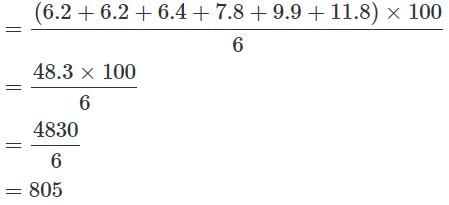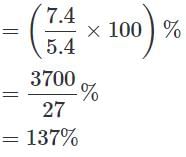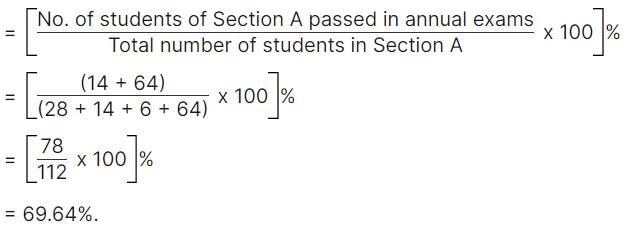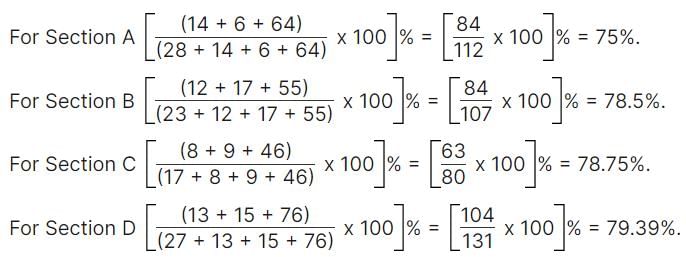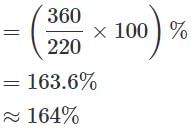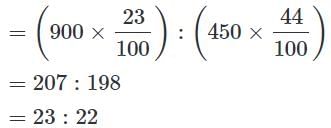MCQ Test: Tabular Graph - 1 - Bank Exams MCQ
20 Questions MCQ Test Data Interpretation for Competitive Examinations - MCQ Test: Tabular Graph - 1
Study the following table and answer the questions.
Classification of 100 Students Based on the Marks Obtained by them in Physics and Chemistry in an Examination.

Q. What is the different between the number of students passed with 30 as cut-off marks in Chemistry and those passed with 30 as cut-off marks in aggregate?

Study the following table and answer the questions.
Classification of 100 Students Based on the Marks Obtained by them in Physics and Chemistry in an Examination.

Q. If it is known that at least 23 students were eligible for a Symposium on Chemistry, then the minimum qualifying marks in Chemistry for eligibility to Symposium would lie in the range?

Study the following table and answer the questions.
Classification of 100 Students Based on the Marks Obtained by them in Physics and Chemistry in an Examination.

Q. If at least 60% marks in Physics are required for pursuing higher studies in Physics, how many students will be eligible to pursue higher studies in Physics?

Study the following table and answer the questions.
Classification of 100 Students Based on the Marks Obtained by them in Physics and Chemistry in an Examination.

Q. The percentage of number of students getting at least 60% marks in Chemistry over those getting at least 40% marks in aggregate, is approximately?
Study the following table and answer the questions.
Classification of 100 Students Based on the Marks Obtained by them in Physics and Chemistry in an Examination.

Q. The number of students scoring less than 40% marks in aggregate is?
Directions: Study the given table carefully and answer the question that follow:
Number of candidates appeared and qualified for a test (in hundreds) in 6 different years from 5 different zones.
Note: Here App. means Appeared and Qual. Means qualified.
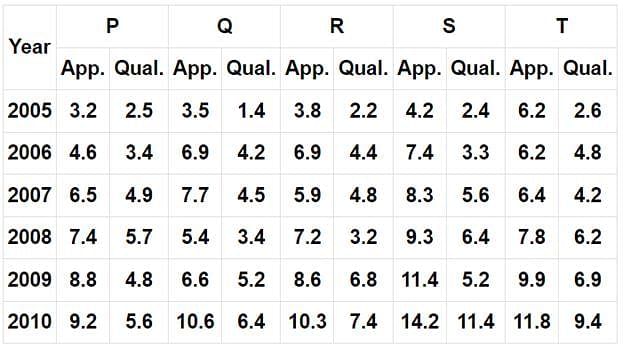
Q. What was the average number of candidates appeared from zone T over all the years together?
Directions: Study the given table carefully and answer the question that follow:
Number of candidates appeared and qualified for a test (in hundreds) in 6 different years from 5 different zones.
Note: Here App. means Appeared and Qual. Means qualified.

Q. What was the ratio of the number of candidates appeared from zone P in the year 2005 to the number to the number of candidates qualified from zone S in the year 2007?
Directions: Study the given table carefully and answer the question that follow:
Number of candidates appeared and qualified for a test (in hundreds) in 6 different years from 5 different zones.
Note: Here App. means Appeared and Qual. Means qualified.

Q. In which years was in zones the different between the appeared candidates and qualified candidates the second lowest?
Directions: Study the given table carefully and answer the question that follow:
Number of candidates appeared and qualified for a test (in hundreds) in 6 different years from 5 different zones.
Note: Here App. means Appeared and Qual. Means qualified.

Q. The number of candidates who qualified the test from zone R in the year 2010 was approximately what percentage of the number of candidates who appeared from zone Q in the year 2008?
Directions: Study the given table carefully and answer the question that follow:
Number of candidates appeared and qualified for a test (in hundreds) in 6 different years from 5 different zones.
Note: Here App. means Appeared and Qual. Means qualified.

Q. From which zone was the total number of candidates who qualified the test, the second highest in the year?
A school has four sections A, B, C, D of Class IX students.
The results of half yearly and annual examinations are shown in the table given below.
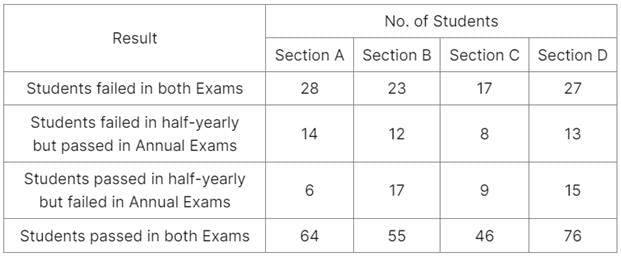
Q. If the number of students passing an examination be considered a criteria for comparision of difficulty level of two examinations, which of the following statements is true in this context?
A school has four sections A, B, C, D of Class IX students.
The results of half yearly and annual examinations are shown in the table given below.
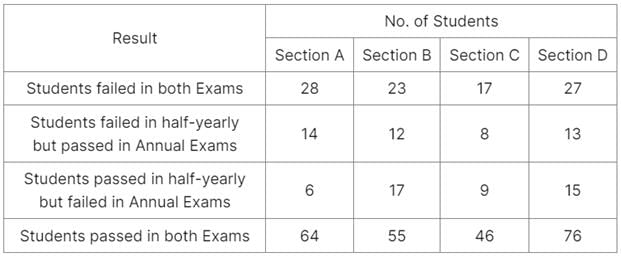
Q. Which section has the minimum failure rate in half yearly examination?
A school has four sections A, B, C, D of Class IX students.
The results of half yearly and annual examinations are shown in the table given below.
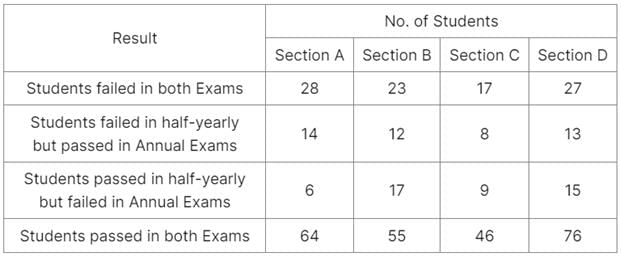
Q. How many students are there in Class IX in the school?
A school has four sections A, B, C, D of Class IX students.
The results of half yearly and annual examinations are shown in the table given below.
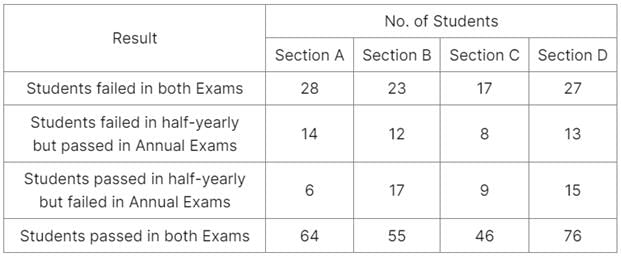
Q. Which section has the maximum success rate in annual examination?
A school has four sections A, B, C, D of Class IX students.
The results of half yearly and annual examinations are shown in the table given below.
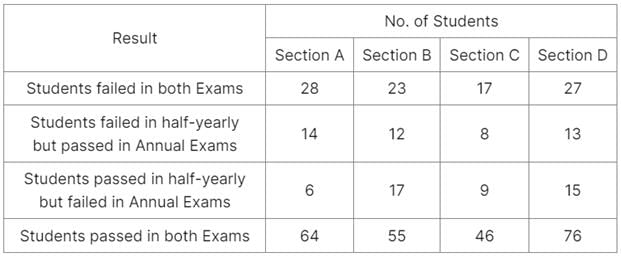
Q. Which section has the maximum pass percentage in at least one of the two examinations?
Directions: Study the table given below and answer the questions that follow:
Total Number of Employees in different Departments of an Organization and Percentage of Females and Males.
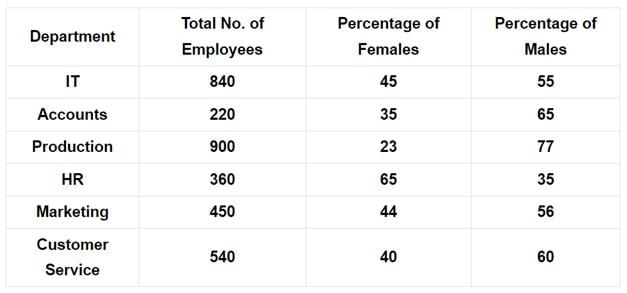
Q. What is the total number of employees in all the departments together?
Directions: Study the table given below and answer the questions that follow:
Total Number of Employees in different Departments of an Organization and Percentage of Females and Males.
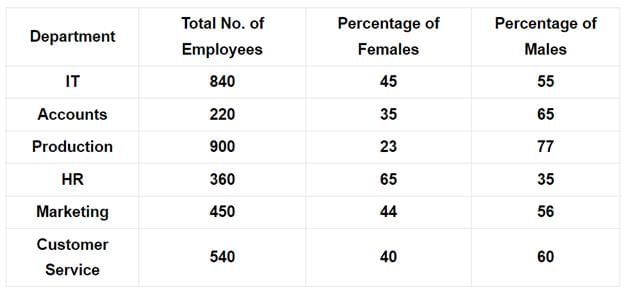
Q. The total number of employees in the HR department forms approximately what per cent of the total number of employees in the Accounts department?
Directions: Study the table given below and answer the questions that follow:
Total Number of Employees in different Departments of an Organization and Percentage of Females and Males.
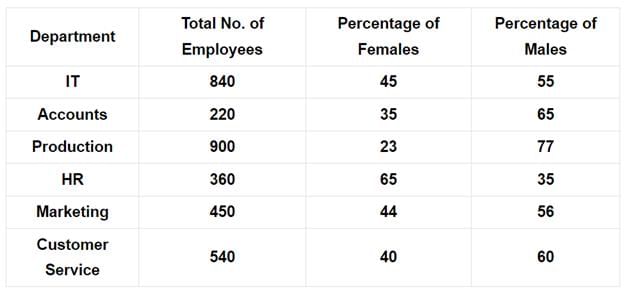
Q. What is the respective ratio of the number of females in Production department to the number of females in the Marketing department?
Directions: Study the table given below and answer the questions that follow:
Total Number of Employees in different Departments of an Organization and Percentage of Females and Males.
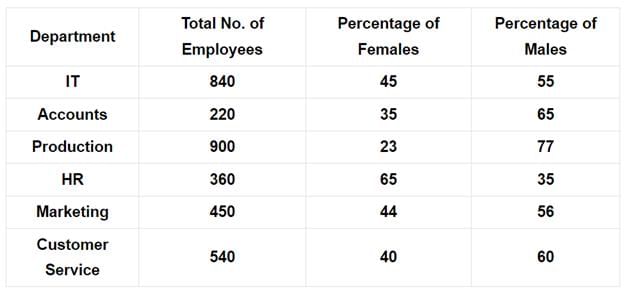
Q. What is the ratio of the number of females in the HR and Accounts department together to the number of males in the same department together?
Directions: Study the table given below and answer the questions that follow:
Total Number of Employees in different Departments of an Organization and Percentage of Females and Males.
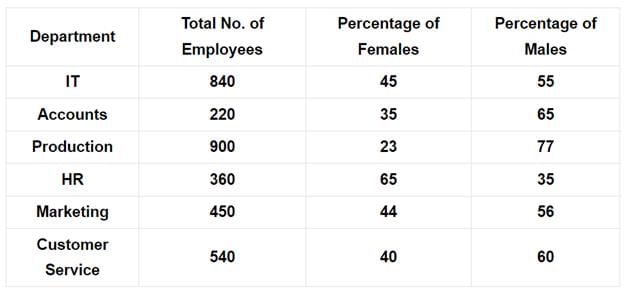
Q. What is the total number of males in the IT and Customer Service departments together?
|
13 videos|20 docs|23 tests
|
|
13 videos|20 docs|23 tests
|






